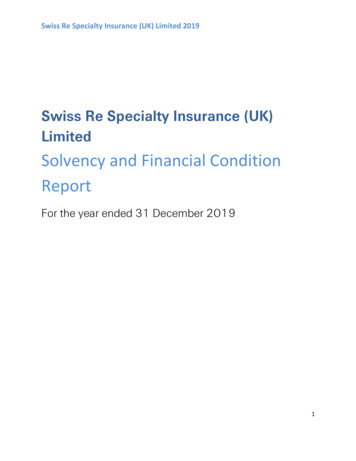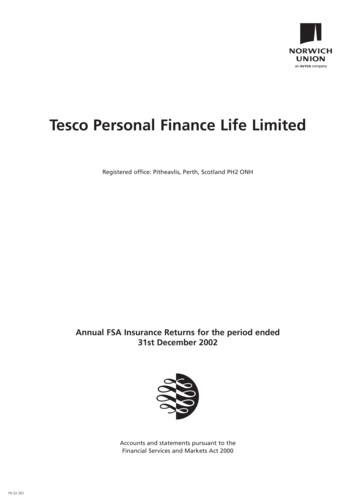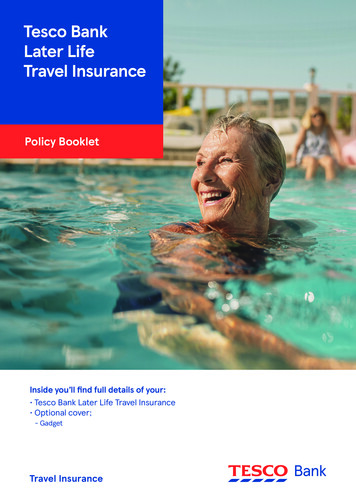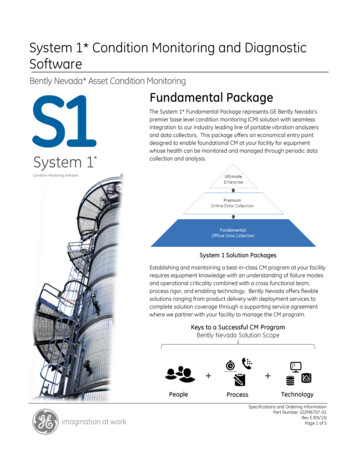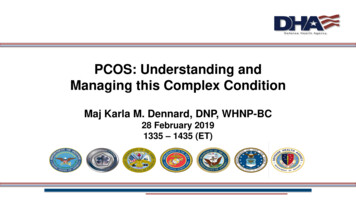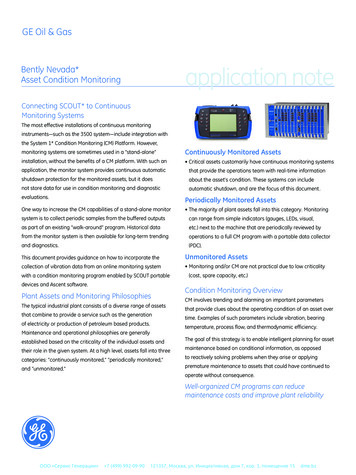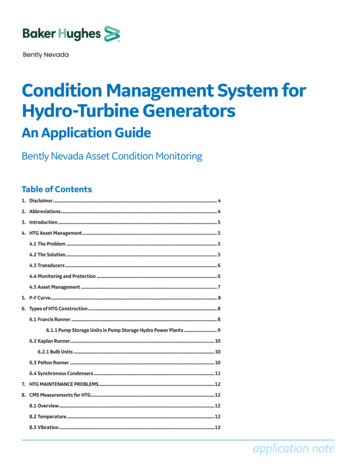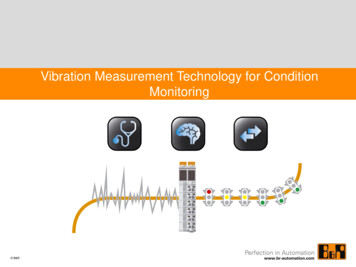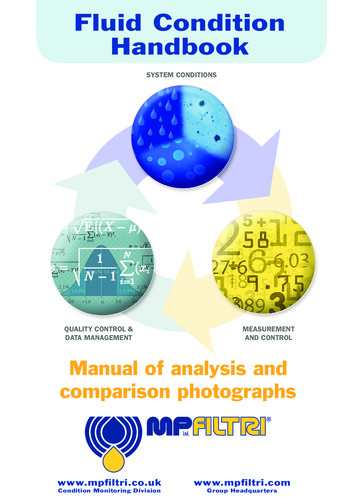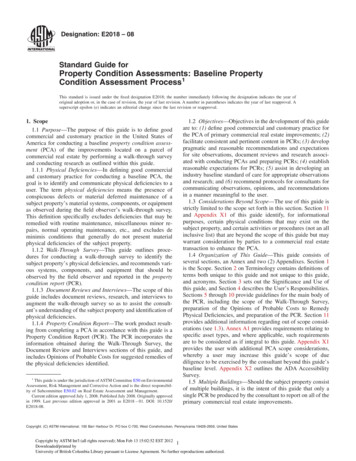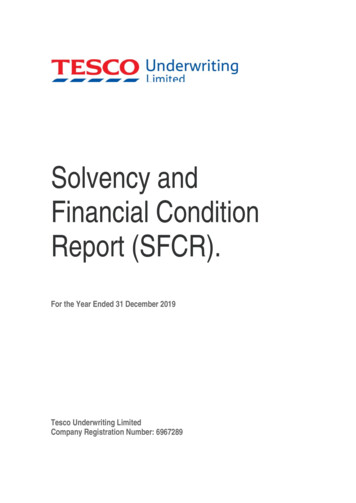
Transcription
Solvency andFinancial ConditionReport (SFCR).For the Year Ended 31 December 2019Tesco Underwriting LimitedCompany Registration Number: 6967289
CONTENTSSUMMARYA) Business and performanceB) System of governanceC) Risk profileD) Valuation for solvency purposesE) Capital management445667DIRECTORS' STATEMENT8AUDITOR'S STATEMENT9A. BUSINESS AND PERFORMANCE13A.1 BusinessA.2 Underwriting PerformanceA.3 Investment PerformanceA.4 Performance of other activitiesA.5 Any other informationB. SYSTEM OF GOVERNANCE141517181819B.1 General information on the system of governanceB.2 Fit and proper requirementsB.3 Risk management system including the own risk and solvency assessmentB.4 Internal control systemB.5 Internal audit functionB.6 Actuarial functionB.7 OutsourcingB.8 Any other information 2 2022253641434344
C. RISK PROFILE45C.1 Underwriting riskC.2 Market riskC.3 Credit riskC.4 Liquidity riskC.5 Operational riskC.6 Other material risksC.7 Any other information47505152535556D. VALUATION FOR SOLVENCY PURPOSES62D.1 AssetsD.2 Technical provisionsD.3 Other liabilitiesD.4 Alternative methods for valuationD.5 Any other informationE. CAPITAL MANAGEMENT636673767677E.1 Own fundsE.2 Solvency Capital Requirement and Minimum Capital RequirementE.3 Use of the duration-based equity risk sub-module in thecalculation of the Solvency Capital RequirementE.4 Differences between the Standard Formula and any Internal Model usedE.5 Non-compliance with the Minimum Capital Requirement andnon-compliance with the Solvency Capital RequirementE.6 Any other informationAPPENDIX: ANNUAL QUANTATITIVE REPORTING TEMPLATES (QRTs) 3 788182828484
SUMMARYThis is the fourth Solvency and Financial Condition Report (SFCR) for Tesco Underwriting Limited (TU, the Company). Allamounts in the tables of this SFCR are denominated in ’000, unless stated otherwise.A. Business and PerformanceTesco Underwriting Limited (TU) is a partnership between Ageas (UK) Limited and Tesco Personal Finance plc, with Ageas(UK) Limited owning 50.1% and Tesco Personal Finance plc 49.9%. Tesco Underwriting Limited is authorised by thePrudential Regulation Authority (PRA) and regulated by the Financial Conduct Authority (FCA) and the PRA.During 2019 TU continued its underwriting of personal lines insurance business (car and home) distributed by TescoPersonal Finance plc.TU has been compliant with Solvency II requirements from the beginning of 2016 and had capital resources of 160%(2018:145%) of its Solvency Capital Requirement (SCR) at year end.In March 2019, the Board authorised a dividend payment of 31.3m and a repayment of subordinated debt of 15.7mfollowing a share capital reduction of 16m. Post these changes, PIM SCR coverage was estimated at 145%.2019's IFRS profit before tax was 28.4m. Within the Motor portfolio, the Ogden discount rate change from -0.75% to 0.25% on 15 July 2019 resulting in a 7.4m increase in profit. The underlying motor performance showed large bodily injurylosses for the current accident year being offset by positive development from prior accident years. Within the Homeportfolio the current year result was impacted by favourable weather conditions.At the end of December 2019 TU’s capital position was: Solvency II Own funds - 189.7mApproved Partial Internal Model (PIM) Capital Requirement - 118.5mSolvency Ratio - 160%.The vision for the Company is to be the "Insurer of choice for Tesco Customers" whilst the overall role for TU is to maintaina profitable position within the UK personal lines car and home market supporting the Tesco Personal Finance plc personallines insurance strategy.TU operates in a highly competitive market place with the uncertainty of forthcoming significant regulatory changeincluding: Ogden rate changes, Whiplash and Ministry of Justice Reforms, ongoing Solvency II requirements as well asrenewal transparency.During 2019 there were no material changes to the business in the context of this report, but it is worth noting that 2019business profitability and revisions in the Ogden discount rates have favourably impacted the levels of capital within thebusiness. 4
Throughout 2019 TU has maintained a regular dialogue with the PRA including updates on actual and expected capitalcoverage as well as face to face meetings on business progress and sharing of Board papers.In February 2020 TU convened a COVID-19 Core Response team from across the business which reports into the TUExecutive Committee twice weekly. The situation has developed rapidly and at the time of writing TU has implementedCrisis Management with daily calls and strong focus through the Crisis Management Team. Following Boris Johnson’sannouncement on 23rd March, TU has closed its Reigate office whilst maintaining attendance of a proportion of the staff inthe Claim operation in Newcastle in order to maintain claims handling which cannot be undertaken remotely. However,staffing is commensurate with the reduced volumes of calls being received which at this point are about 60% less thanplan.The directors consider that the financial impact of the COVID-19 virus on the UK economy and the company cannotcurrently be estimated with any degree of certainty. In assessing the potential impact on the company, the directors haveprepared various financial projections of impacts including reduced claims costs, investment value variability, operatingexpenses and premium income on the basis of a UK shutdown lasting around 3 months with a return to normal trading overthe following 3 to 6 months and taking account of anticipated management actions and UK government support.B. System of GovernanceThe decision making framework within TU has been defined by the shareholders. In accordance with the terms of theShareholder Agreement, the TU Board has been delegated responsibility by TU's shareholders for the overall direction andsupervision of the Company. The framework reflects the principle of delegated authority based on competence andappropriate mechanisms and triggers for escalation.The role of the TU Board is to provide oversight of TU’s business and exercise control over the business ensuring thedirection and performance of the business is aligned to shareholder objectives and is managed competently and prudentlyin accordance with legislative and regulatory requirements. The Board delegates authority to certain committees in orderthat they may monitor and oversee specific aspects of the business without reference to the Board. The committees areaccountable to the Board, and responsibility rests with the Board.The TU Board has delegated authority and responsibility for key activities to designated Senior Managers in accordancewith the requirements of SM&CR. The allocation of significant responsibilities is documented and maintained within TU'sGovernance Map.TU has put in place policies and procedures that provide evidence of fitness and propriety for Directors, Senior Managersand those responsible for discharging a key function. Supporting documentation is collated prior to appointment, and inconjunction with the recruitment and appointment processes, which provides information on the individual’s skills andexperience.TU operates a “Three Lines of Defence” governance model to provide management with reasonable assurance that thecompany is run in a proper way. TU management and staff have the primary responsibility for owning and managing risks(First Line of Defence). Oversight of the effective operation of the internal control framework is supported by the RiskManagement and Compliance functions (Second Line of Defence). Internal Audit provide independent verification andchallenge of the adequacy and effectiveness of the internal risk and control framework (Third Line of Defence).The goal of TU’s approach to risk management is to ensure that all significant risks are understood and effectivelymanaged through a well-designed risk management framework. The objective of such a framework is to add value to thebusiness as well as ensure adequate systems and controls operate. 5
C. Risk ProfileTU defines risk as the deviation from anticipated outcomes that may have an impact on its solvency, earnings, liquidity,customers and/or reputation and therefore its business objectives and/or future opportunities. TU’s risks therefore stemfrom its exposure to both external and internal risk factors in conducting its business activities. TU only seeks to take onrisks that: It has a good understanding of (i.e. is within current expertise and available information);Can be adequately managed at both the individual and overall portfolio level;Are affordable (i.e. within the TU risk appetite); andHave an acceptable risk-reward trade-offThe most significant risks that TU is exposed to are: Non-Life Insurance risk, Market Risk and Operational Risk – these andall risks with the TU Taxonomy are managed through a combination of polices, processes and reports. The key risks arereviewed quarterly by the Management Risk Committee (MRC) and subsequently by the Board Risk Committee (BRC).The monitoring of these risks as assessed by the business (First Line) is facilitated by the quarterly Control Risk SelfAssessment (CRSA) process, and articulated around the annual Strategic Planning and ORSA (Own Risk and SolvencyAssessment) processes, supported by relevant modelling approaches.D. Valuation for Solvency PurposesThe valuation of assets and liabilities for Solvency II purposes is the same as IFRS except for: DAC, other intangibles, tangible fixed assets and prepayments are excluded from the SII balance sheet. Deferred tax is adjusted to reflect the tax impact of the valuation adjustments. Reinsurance assets (claim recoveries) are discounted for SII balance sheet purposes. Technical provisions (claims reserves and unearned premium reserves) are discounted for SII balance sheetvaluation purposes. Subordinated debt within the IFRS balance sheet classified as subordinated liabilities has been reclassified fromliabilities to own funds in line with SII requirements. Each of the eligibility criteria required for the subordinateddebt to qualify as Tier 2 capital, as set out in Article 73 of delegated regulation (EU) 2015/35 have been met.The debt is fully subordinated in the event of a winding up, with the claims of the holder of the debt subordinatedto the claims of the senior creditors (including policyholders and non-subordinated creditors). The subordinateddebt is fully available to absorb losses and is free from encumbrances.Key valuation adjustments are shown in the table between IFRS and SII balance sheet illustrated below: 6
Actual 2019Actual 2018165,379165,51442,33358,000Total valuation differencesRemoval of DACsDerecognition of tangible and intangible assetsDerecognition of prepaymentsNet discounting to PV of insurance assetsNet best estimate of liabilitiesTax impact on valuation differencesForseeable 79(2,176)(47,000)Total Solvency II Own Funds (PIM)189,735185,793IFRS EquitySubordinated liabilitiesThe SII Own Funds increased in 2019 relative to 2018. This difference is driven partly by the Ogden discount rate being 0.25% in IFRS in 2019 compared to -0.75% in 2018, compared to the Solvency I change from 0% in 2018 to -0.25% in2019. Also partly by the removal of DAC adjustment against reducing commission rates and falling volumes and partly bythe use of the volatility adjuster in the valuation of Technical provisions.E. Capital ManagementTU operates a capital contingency plan which gives the business guidance on actions / considerations at different SIIcapital coverage levels. For example, TU successfully implemented its Capital Contingency Plan in the first quarter of 2017following the announcement of the reduction in the Ogden discount rate to minus 0.75% on 27th February 2017. Togetherwith 2017 profitability and the implementation of additional reinsurance this increased TU's coverage from 101% to 169% atthe end of 2017.At the end of 2019 TU had SII own funds of 189.7m (2018: 185.8m). With the TU SCR PIM at 118.5m at the end of2019 (2018: 128.4m) this resulted in capital coverage of 160% (2018: 145%).As TU usually holds bonds to maturity, the volatility adjuster removes the impact of short term volatility on bond yields.Excluding the use of volatility adjuster at the end of 2019, SII own funds would have been 187.6m, leading to a capitalcoverage of 158%.In March 2019 there was a dividend payment of 31.3m and a repayment of subordinated debt of 15.7m. 7
Directors’ StatementApproval by the Board of DirectorsFinancial Year ended 31 December 2019We certify:(a) That the Solvency and Financial Condition Report (“SFCR”) has been prepared in all material respects inaccordance with the PRA Rules and Solvency II Regulations, and(b) We are satisfied that:(i)throughout the financial year in question, Tesco Underwriting has complied in all material respects withthe requirements of the PRA Rules and the Solvency II Regulations as applicable to the insurer, and(ii)it is reasonable to believe that the insurer has continued so to comply subsequently and will continue soto comply in future.Steve KingshottCEOColin AnthonyChief Underwriting Officer6 April 2020 8
Auditor’s StatementReport of the external independent auditor to the Directors of Tesco Underwriting Limited (‘the Company’)pursuant to Rule 4.1 (2) of the External Audit Chapter of the PRA Rulebook applicable to Solvency II firmsReport on the Audit of the Relevant Elements of the Solvency and Financial Condition ReportOpinionExcept as stated below, we have audited the following documents prepared by The Company as at 31 December 2019: The ‘Valuation for solvency purposes’ and ‘Capital Management’ sections of the Solvency and FinancialCondition Report of The Company as at 31 December 2019, (‘the Narrative Disclosures subject to audit’);and Company templates S02.01.02, S12.01.01, S17.01.02, S23.01.01 and S28.01.01 (‘the Templates subject toaudit’).The Narrative Disclosures subject to audit and the Templates subject to audit are collectively referred to as the ‘RelevantElements of the Solvency and Financial Condition Report’.We are not required to audit, nor have we audited, and as a consequence do not express an opinion on the OtherInformation which comprises: information contained within the relevant elements of the Solvency and Financial Condition Report set out abovewhich are, or derive from the Solvency Capital Requirement, as identified in the Appendix to this report; the ‘Business and performance’, ‘System of governance’ and ‘Risk profile’ elements of the Solvency andFinancial Condition Report; Company templates S05.01.02, S05.02.01, S19.01.21 and S.25.02.21 the written acknowledgement by management of their responsibilities, including for the preparation of theSolvency and Financial Condition Report (‘the Responsibility Statement’).In our opinion, the information subject to audit in the relevant elements of the Solvency and Financial Condition Report ofThe Company as at 31 December 2019 is prepared, in all material respects, in accordance with the financial reportingprovisions of the PRA Rules and Solvency II regulations on which they are based, as modified by relevant supervisorymodifications, and as supplemented by supervisory approvals and determinations.Basis for opinionWe conducted our audit in accordance with International Standards on Auditing (UK) (ISAs (UK)), including ISA (UK) 800and ISA (UK) 805. Our responsibilities under those standards are further described in the Auditor’s Responsibilities for theAudit of the Relevant Elements of the Solvency and Financial Condition Report section of our report. We are independentof the Company in accordance with the ethical requirements that are relevant to our audit of the Solvency and FinancialCondition Report in the UK, including the FRC’s Ethical Standard as applied to public interest entities, and we have fulfilledour other ethical responsibilities in accordance with these requirements. We believe that the audit evidence we haveobtained is sufficient and appropriate to provide a basis for our opinion.Conclusions relating to going concernWe have nothing to report in respect of the following matters in relation to which the ISAs (UK) require us to report to youwhere: the directors’ use of the going concern basis of accounting in the preparation of the SFCR is not appropriate; or the directors have not disclosed in the SFCR any identified material uncertainties that may cast significant doubtabout the company’s ability to continue to adopt the going concern basis of accounting for a period of at leasttwelve months from the date when the SFCR is authorised for issue. 9
Emphasis of Matter – Basis of AccountingWe draw attention to the ‘Valuation for solvency purposes’ and ‘Capital Management’ sections of the Solvency andFinancial Condition Report, which describe the basis of accounting. The Solvency and Financial Condition Report isprepared in compliance with the financial reporting provisions of the PRA Rules and Solvency II regulations, and thereforein accordance with a special purpose financial reporting framework. The Solvency and Financial Condition Report isrequired to be published, and intended users include but are not limited to the PRA. As a result, the Solvency and FinancialCondition Report may not be suitable for another purpose. Our opinion is not modified in respect of these matters.Other InformationThe Directors are responsible for the Other Information.Our opinion on the relevant elements of the Solvency and Financial Condition Report does not cover the Other Informationand we do not express any form of assurance conclusion thereon.In connection with our audit of the Solvency and Financial Condition Report, our responsibility is to read the OtherInformation and, in doing so, consider whether the Other Information is materially inconsistent with the relevant elements ofthe Solvency and Financial Condition Report, or our knowledge obtained in the audit, or otherwise appears to be materiallymisstated. If we identify such material inconsistencies or apparent material misstatements, we are required to determinewhether there is a material misstatement in the relevant elements of the Solvency and Financial Condition Report or amaterial misstatement of the Other Information. If, based on the work we have performed, we conclude that there is amaterial misstatement of this Other Information, we are required to report that fact. We have nothing to report in this regard.Responsibilities of Directors for the Solvency and Financial Condition ReportThe Directors are responsible for the preparation of the Solvency and Financial Condition Report in accordance with thefinancial reporting provisions of the PRA rules and Solvency II regulations which have been modified by the modifications,and supplemented by the approvals and determinations made by the PRA under section 138A of FSMA and the PRARules and Solvency II regulations on which they are based.The Directors are also responsible for: such internal control as management determines is necessary to enable the preparation of a Solvency andFinancial Condition Report that is free from material misstatement, whether due to fraud or error; overseeing the Company’s financial reporting process; and assessing the company’s ability to continue as a going concern, disclosing, as applicable, matters related togoing concern; and using the going concern basis of accounting unless they either intend to liquidate thecompany or to cease operations, or have no realistic alternative but to do so.Auditor’s Responsibilities for the Audit of the relevant elements of the Solvency and Financial Condition ReportIt is our responsibility to form an independent opinion as to whether the relevant elements of the Solvency and FinancialCondi
Tesco Underwriting Limited (TU) is a partnership between Ageas (UK) Limited and Tesco Personal Finance plc, with Ageas . Non-Life Insurance risk, Market Risk and Operational Risk – these and all risks with the TU Taxonomy are managed through a
